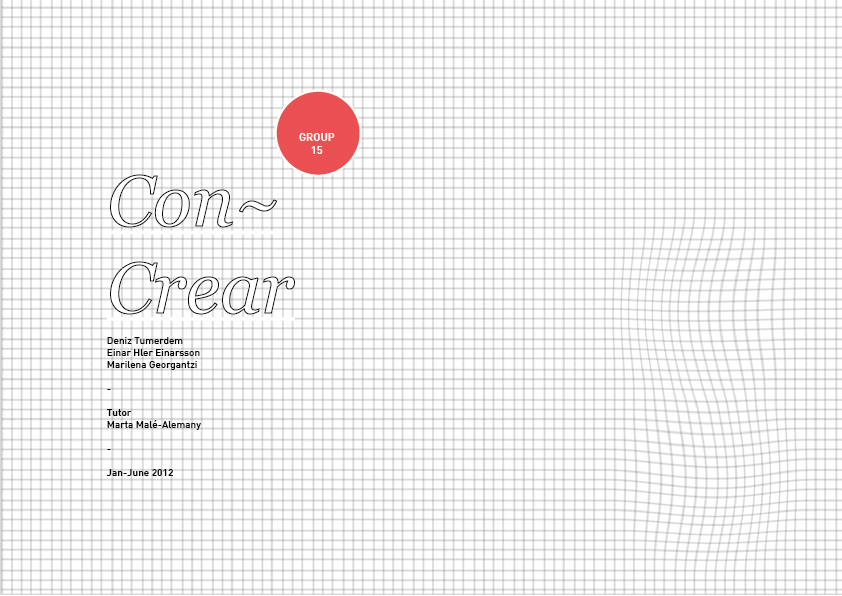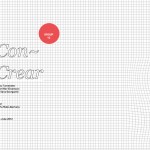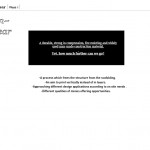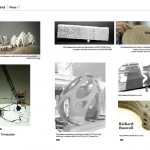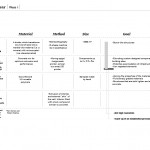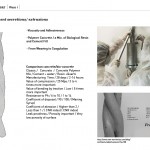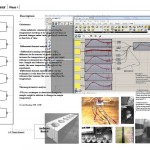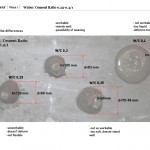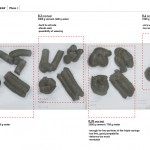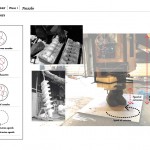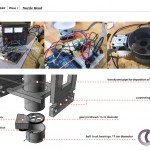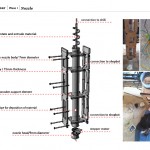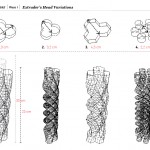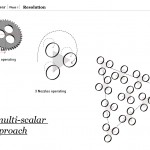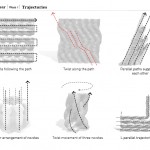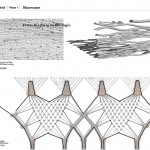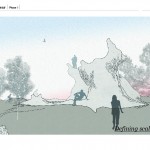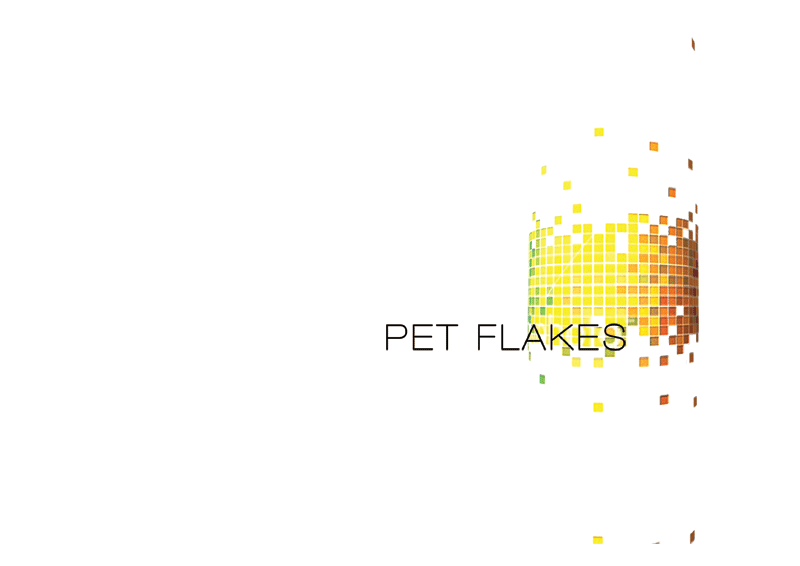Poro-city is an investigation into 3D printing lightweight structures comprised of materials with variable compositions. Taking inspiration from trabecula bones, Poro-city integrates computational form-finding strategies with biologically inspired fabrication. Concrete independently has a high compression strength but what limits its structural capability is the heavy weight of the material. By combining concrete with Styrofoam balls, the resulting material has the added advantage of being lighter yet still structural. Depending on the added number of Styrofoam balls, the resulting material will have a wide range of variable densities, and therefore a correlating structural performance level. This gradation ranges from an extremely lightweight, nonstructural material, to an extremely heavy and structural material. With the help of computational optimization softwares, Poro-city will be able to identify the level of structural requirements in the design and therefore, the correlating composition of the variable material required. By printing functionally graded concrete with variable compositions combined with optimization softwares, Poro-city will allow for not only the production of structures that are lighter, stronger, and more freeform, but also structures that can be optimized in terms of its strength, weight and material usage.
Magnetic Architecture Midterm Review
Final Video presentation of our project dealing with the design investigation involving the use of magnetic material shaped by using magnets.
CON-CREAR
PET-FLAKES
RS3 Digital Tectonics – SYLLABUS
With the advent of the information society,architecture is no longer built but manufactured. The techniques of digital production have put the architect back t the centre of the construction process because the information generated in the design process is literally used to manufacture the various parts of a building. Digital technology has thus gone beyond the representation stage to take its place precisely in the production phase of architecture. In the light of this, parametric design makes it possible to approach the architecture project on everything from the territorial scale to the urban design of the building, in an open fashion, integrating algorithms and dynamic formulations in the project-design process itself.
With the development of new software, scripting techniques can now be integrated into architectural design, transforming theold plastic principles by the insertion of mathematical logics into the project. In order to experiment with these projectdesign processes, digitally control machines are used to produce scale models of the esigns and prototypes of projects at 1:1 scale.
The IAAC has a workshop for the production of full-scale prototypes equipped with digital fabrication machines, including a 320 x 120 cm CNC cutter, a laser machine, and 3D printer.
STUDIO BRIEF RS3 – 2011-12
FABBOTS 3.0 BUILDING AUTONOMY
Continuing on the research from the past 2 editions, the Digital Tectonics Research Studio 2011-12 will investigate the workflow between computational design and material production methods, exploring the relationship between design inputs and computer programmable devices that can be used for the production of building structures and/or components. Challenging the traditional norms of linear file-to-factory production processes, the studio will study the potentials of linking the programming of specific material formations and machinic behaviour in real time, exploring the generative design opportunities that may emerge from this convergence.
With support tutorials and exercises focusing on the creation of custom-designed innovative hardware devices that incorporate sensory inputs and stepper motor control, the studio aims to propose alternatives to existing methods of digital fabrication to be deployed on-site. As these fabrication devices will enable a direct response to sensory inputs, systems of behavioural rules can be considered to influence the method of creating building elements or structures. Rather than scripting geometrical patterns of formation as in traditional uses of digital fabrication, behavioural rule systems can be used to direct machinic fabrication towards certain performance criteria scenarios, thus generating emergent material configurations that are not guided from a pre-concieved design. Using a setup consisting of design scripts, machine programming, a custom designed fabrication device and specific method of material formation, students teams will choreograph the creation of material structures that demonstrate that their formation has been influenced by external inputs like sound, light, temperature etc.
The studio research will focus on how locality allows for hyper-specific outcomes, as the variables of the specific context (temperature, solar exposure, prevailing winds, etc.) are simultaneously embedded and recorded in the material result. Considering that the production processes are dependent on external factors on site, recorded data will be physically translated and materialized in outcomes that contain both programmed design intentions and information from the environment. As such, material formations will be emergent and ‘harvested’ from the context. Moreover, the studio will emphasize the global preoccupation with dwindling energy resources, by encouraging formation methods and devices that can employ local materials and be powered by renewable sources of energy.
FACULTY
STUDIO FACULTY:
MARTA MALÉ-ALEMANY (Senior Studio Faculty)
JORDI PORTELL (Assistant)
SUPPORT SEMINAR 1:
COMPUTATION FOR OPTIMIZATION
Taught by SANTIAGO MARTÍN LAGUNA
Through a global multidisciplinary overview, the Studio Support Seminar 1 will help define the processes to optimize an idea; starting from the concept and decision making and continuing with digital and generative design tools to get the best solution for each problem. Looking at nature to inspire the evolutionary optimization processes, students will learn how to modelize and simulate physical and geometrical behaviours, which ought to help them in the development their projects.
SUPPORT SEMINAR 2:
Coordinated by MARTA MALÉ-ALEMANY + JORDI PORTELL
The Studio Support Seminar 2 will provide the fundamental research content, to complement and develop the proposed studio research agenda. Classes are conceived as a series of invited guest lectures by academics and professionals with various fields of expertise. Invited guests may include:
JAVIER PEÑA (FAD Matter / Additive Manufacturing)
MAGÍ GALINDO (LEITAT Technological Center / Additive Manufacturing)
CARLOS GARCÍA PANDO (PRODINTEC Foundation / Materials for Additive Manufacturing)
GUSTAVO MOSCARDO (KUKA Robotics / Robotics)
SANTIAGO MARTÍN GONZÁLEZ (University of Oviedo / Artificial Vision)
JAIME PEINADOR (Director AAGE HEMPEL / Electronics and Mechanical engineering)
JESUS HERRERA (FREMM Murcia / Electronics and Mechanical engineering)
+ others





